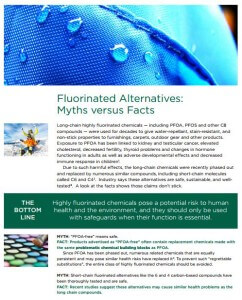February 2017: Consuming Toxic Chemicals with our Fast Food?
In this edition:
- Dupont to Pay $671 Million Settlement
- Are Fluorinated Alternatives Really Better?
- Q: What do deep sea creatures and your house dust have in common? A: Both contain persistent and toxic flame retardant chemicals.
- No one-size-fits-all solution for responsibly disposing of products containing flame retardants
- You’re invited: Focus groups on Six Classes videos March 9 or 10

Since our last newslettter we have made significant progress with our efforts to reduce the use of highly fluorinated stain and water repellents. Our joint paper Fluorinated compounds in US fast food packaging was downloaded over 4,000 times in the first week after publication, and received major press coverage around the world. The paper illuminates the widespread use of these chemicals in food packaging – the first step towards reducing their use. Several fast food chains had not known their packaging contained fluorinated chemicals and the potential for harm. Now, thanks to our paper, they know they are using these chemicals and can consider stopping.
Yesterday, we helped publicize The Never Ending Story?, another peer-reviewed paper which reveals how PFOA, a phased-out fluorinated chemical has been replaced by many hundreds of related “chemical cousins” with similar potential for harm. Such broad press coverage on this persistent class of chemicals could be a turning point for reducing their use.
Be sure to check out our factsheet – online for the first time today – “Fluorinated Alternatives – Myths versus Facts” which documents the harm of replacements to phased-out long-chain highly fluorinated chemicals. More below.
We would be most appreciative if you might consider joining an hour-long focus group on March 9 or 10 to give us feedback about our new three-minute- long Six Classes videos. See below.
During our February 9 workshop on reducing the use of fluorinated chemicals in food packaging, scientists, innovators, government, and representatives of the supply chain came together to develop plans for healthier food packaging. We were inspired to learn how the Danish Coop had phased out fluorinated chemicals, BPA, and other harmful classes of chemicals in food packaging and textiles some years ago. Our objective is for the US to follow their lead.
We are heartened to see so much more awareness and action around highly fluorinated chemicals just two years after the publication of our Madrid Scientific Consensus Statement first brought national attention to this most persistent class of chemicals of concern.
We thank you for your interest in and support of our work.
Arlene and the Green Science Policy Team
Dupont to Pay $671 Million Settlement

A large, enthusiastic audience participated in our February 10 annual Flame Retardant and Beyond Symposium.
One highlight was Rob Bilott, The Lawyer Who Became Dupont’s Worst Nightmare, sharing his dramatic 18 year-long saga of working to obtain justice for clients harmed by these chemicals. Rob abruptly left our meeting on Friday afternoon because of urgent work, and, to our great surprise, we learned early Monday that DuPont had agreed to pay nearly $671 million to settle over three thousand personal injury claims from drinking water contaminated with a highly fluorinated chemical called PFOA used to make Teflon. The 200 plaintiffs with cancer are expected to receive at least $1 million each, while those with high cholesterol could receive five-figure awards. Their saga is eloquently recounted here.
Bravo that those harmed by what a judge called “actual malice ” on Dupont’s part are receiving some compensation.
Are Fluorinated Alternatives Really Better?

Our flyer, “Fluorinated Alternatives – Myths versus Facts,” which debunks industry claims with science demonstrating the harmful properties of the replacement chemicals.
Highly fluorinated chemicals have been used for decades to give water-repellant, stain-resistant, and non-stick properties to products such as furnishings, carpets and outdoor gear. The long-chain chemicals were phased out from U.S. production due to their health and environment hazard. Industry now claims that replacements from the same chemical family are safe, sustainable, and well-tested.
Like their predecessors, the new fluorinated chemicals are extremely persistent and will remain in the environment for generations to come. What’s more, the new short-chain compounds are more difficult to remove from water and more likely to make their way into food crops. To learn more, click on the Myths versus Facts flyer.
Q: What do deep sea creatures and your house dust have in common? A: Both contain persistent and toxic flame retardant chemicals.

Small crustaceans in the Mariana trench, more than six miles below the surface of the ocean, were found to be contaminated with 50 times more toxic flame retardant chemicals than similar creatures in polluted rivers in China.
Researchers sampled deep sea trenches for polybrominated diphenyl ether flame retardants (PBDEs) and polychlorinated biphenyls (PCBs). PBDEs and PCBs are persistent organic pollutants (POPs), that do not break down in the environment, and accumulate in and are toxic to living organisms. POPs can be transported across the globe, resulting in contamination of polar regions. This study demonstrates that these POPs can also accumulate in the deep sea.
Just as we are exposed to flame retardants through ingestion of contaminated house dust, creatures in deep-sea trenches are exposed to contaminated food and plastic particles that sink to the ocean floor. This study demonstrates the global impacts of pollution and the need to limit the production of hazardous chemicals. Read more in The Economist and The Guardian.
No one-size-fits-all solution for responsibly disposing of products containing flame retardants

On February 8th, over twenty participants came to our latest workshop on the Responsible Disposal of Flame Retarded Foam and Plastic: Developing the Basic Science. Presentations included identifying flame retardants in products, how flame retardants might escape from different plastics, issues with landfills and flame retardants, and possible methods for destroying flame retardants.
Participants agreed that there is not a one-size-fits-all approach and many solutions will be needed to deal with the responsible disposal of tens of millions of toxic couches in American homes. Some industry experts are planning to work with academic scientists on pilot-scale projects to evaluate destruction technologies. However, the consensus was that the only really responsible solution to the disposal problem was not to add flame retardants and other persistent and toxic chemicals to our consumer products in the first place.
You’re invited: Focus groups on Six Classes videos March 9 or 10
We are developing a series of three-minute-long webinar videos about the Six Classes of chemicals of concern. We would very much appreciate your participation in a focus group to preview the videos, gather feedback on their effectiveness, and identify opportunities for improvement. The sessions will take place via phone and webinar on Thursday, March 9 at 9:00am, 12:00pm, and 3:00pm Pacific time and on Friday, March 10 at 9:00am Pacific.
Each session will include two three-minute webinars, each followed by a facilitated discussion.
If you, or a colleague or friend, would like to contribute an hour of your time to help us improve these webinar videos, please sign up here by Thursday March 2, 2017. Questions can be directed to [email protected]. Note that space is limited and participants will be offered a gift certificate.
We thank you in advance for giving us your feedback on our videos to provide education on chemical classes of concern for a healthier world.
Receive Updates By Email
Subscribe to our monthly newsletter and get these updates delivered right to your inbox!